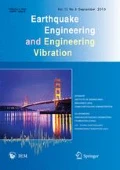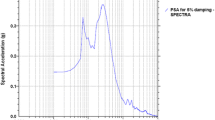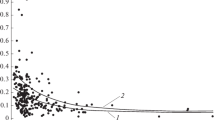Abstract
This paper describes static and dynamic procedures to calculate seismic demand specified by the current seismic design code for buildings in Taiwan, which was issued in 2005. For design levels with a return period of 475 years, the design spectral response acceleration can be developed for general sites, near-fault sites and Taipei Basin. In addition, in order to prevent building collapse during extremely large earthquakes and yielding of structural components and elements during frequent small earthquakes, the required seismic demands at the maximum considered earthquake level (MCE, 2%/50 years) and operational level are also included in the new seismic design code. For dynamic analysis procedures, both the response spectrum method and time history method are specified in the new seismic design code. Finally, procedures to generate spectrum compatible ground motions for time history analysis are illustrated in this paper.
Similar content being viewed by others
References
Chai JF, Liao WI, Teng TJ and Loh CH (2001), “Current Development of Seismic Design Code to Consider the Near-fault Effect in Taiwan,” Earthquake Engineering and Engineering Seismology, 3(2): 47–56.
Chai JF, Loh CH and Chen CY, (2000), “Consideration of the Near-fault Effect on Seismic Design Code for Sites near the Chelungpu Fault,” Journal of the Chinese Institute of Engineers, 23(4): 447–454.
Chai JF, Loh CH and Sato T (2002), “Modeling of Phase Spectrum to Simulate Design Ground Motions,” Journal of the Chinese Institute of Engineers, 25(4): 447–459.
Chai JF, Teng TJ and Yeh CS (2004), “Seismic Microzonation and Design Response Spectrum in Taipei Basin,” Proceedings of the 7th Conference on Structure Engineering, Chung-Li, Taiwan, Paper No. G0021A. (in Chinese)
CPA (2005), Seismic Design Code and Commentary for Buildings, 2005 Edition, Construction and Planning Agency, Ministry of Interior Affair, Chinese Taipei. (in Chinese)
ICBO (1997), Uniform Building Code, 1997 Edition, Whittier, CA.
ICBO (2000), International Building Code, 2000 Edition, Whittier, CA.
Loh CH and Huang YJ (2002), “Seismic Damage Assessment in Taiwan Considering Characteristic Earthquake Model,” Research Report of Center for Research on Earthquake Engineering, NCREE-02-032. (in Chinese)
Author information
Authors and Affiliations
Corresponding author
Rights and permissions
About this article
Cite this article
Chai, JF., Teng, TJ. & Tsai, KC. Development of seismic force requirements for buildings in Taiwan. Earthq. Eng. Eng. Vib. 8, 349–358 (2009). https://doi.org/10.1007/s11803-009-9077-5
Received:
Accepted:
Published:
Issue Date:
DOI: https://doi.org/10.1007/s11803-009-9077-5




